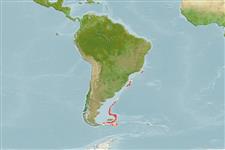Teleostei (teleosts) >
Perciformes/Cottoidei (Sculpins) >
Liparidae (Snailfishes)
Etymology: Careproctus: Greek, kara = face + Greek, proktos = anus (Ref. 45335); aculeolatus: Named for the spiny armament of the body ('aculeolus' = small spine).
More on author: Andriashev.
Environment: milieu / climate zone / depth range / distribution range
Ecology
Marine; bathydemersal; depth range 540 - 700 m (Ref. 30823). Deep-water
Southwest Atlantic: off southern Argentina to southeast of the Falkland Islands.
Size / Weight / Age
Maturity: Lm ? range ? - ? cm
Max length : 11.4 cm TL (female)
Short description
Identification keys | Morphology | Morphometrics
Dorsal soft rays (total): 43; Anal soft rays: 36 - 37; Vertebrae: 48. Peritoneum light colored. Caudal rays 10. Rad. Pect. 3, rounded, without notches. Pleural ribs absent. Hypural plate single with longitudinal fissure. Opercular lobe very thin, transparent. Gill opening extends to the 8th ray of pectoral fin. Skin with very small, sparse bundles of needlelike spines. Pyloric caeca almost tubercle-like. Anterior mandibular pores very close to each other. Head 27-28% SL; anteanal distance 42.5-45% SL (Ref. 41400).
Life cycle and mating behavior
Maturity | Reproduction | Spawning | Eggs | Fecundity | Larvae
Andriashev, A.P., 1998. A review of recent studies of Southern Ocean Liparidae (Teleostei: Scorpaeniformes). Cybium 22(3): 255-266. (Ref. 30823)
IUCN Red List Status (Ref. 130435: Version 2024-1)
Threat to humans
Harmless
Human uses
Fisheries: of no interest
Tools
Special reports
Download XML
Internet sources
Estimates based on models
Preferred temperature (Ref.
123201): 3.3 - 4.1, mean 3.4 °C (based on 7 cells).
Phylogenetic diversity index (Ref.
82804): PD
50 = 0.5000 [Uniqueness, from 0.5 = low to 2.0 = high].
Bayesian length-weight: a=0.00457 (0.00208 - 0.01002), b=3.17 (2.99 - 3.35), in cm total length, based on LWR estimates for this Genus-body shape (Ref.
93245).
Trophic level (Ref.
69278): 3.2 ±0.5 se; based on size and trophs of closest relatives
Resilience (Ref.
120179): High, minimum population doubling time less than 15 months (Preliminary K or Fecundity.).
Fishing Vulnerability (Ref.
59153): Low vulnerability (10 of 100).
